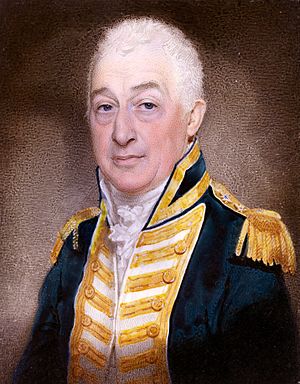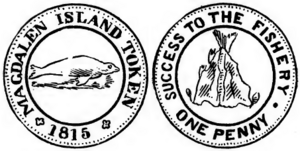Magdalen Island penny token facts for kids
The Magdalen Island penny token was a special coin made for use on the Magdalen Islands and other parts of eastern Canada in the early 1800s. It was created in 1815 by Sir Isaac Coffin, who was given the islands by the British government for being loyal during the American Revolutionary War. This token isn't super rare, but it's hard to find one that isn't very worn out. Even worn tokens can cost around C$100 or more!
Contents
A Look Back: History of the Token
The Magdalen Islands are a small group of islands in the Gulf of Saint Lawrence. Even though they are closer to Prince Edward Island and Nova Scotia, they are part of the Canadian province of Quebec. The islands became part of Quebec in 1774.
Sir Isaac Coffin (1759–1839) was a naval officer who served in the Royal Navy. He fought in the American Revolutionary War and the French Revolutionary Wars. In 1787, he became interested in the Magdalen Islands. He told the government that people from New England were fishing illegally and trading with the islanders. Because Coffin was a loyal supporter of Britain and had lost his family's land in America, he was given the Magdalen Islands in 1798 as a reward for his service.
Coffin wanted to set up a system where he would be like a landlord over the islanders. He brought the penny tokens with him on the only trip he ever made to the islands. However, he couldn't get new settlers to come, and he couldn't get rid of the people who had already moved there from Saint Pierre and Miquelon. The local people didn't like his strict rules. As he left the island, they even shouted, "Whip King George and King Coffin!"
Even though some people said the islanders didn't use the tokens much, it's clear they were used a lot. Most of the tokens found today are very worn. Many tokens were also sent to Nova Scotia, and newspapers from that time mentioned them being used by merchants in Halifax.
What Does the Token Look Like?
One of the special rights Sir Isaac Coffin claimed was the power to make his own money. He asked a company in Birmingham, England, called Edward Thomason, to make the pennies. The design was probably created by an engraver named Thomas Halliday.
The front (called the obverse) of the coin shows a seal resting on a piece of ice. Around the edge, it says 'MAGDALEN ISLAND TOKEN' and the year '1815' at the bottom.
The back (called the reverse) of the coin shows a cod fish. It says 'SUCCESS TO THE FISHERIES', followed by 'ONE PENNY'. The cod fish and the words show how important the fishing industry was to the islands' economy.
How Experts Study These Tokens
Experts who study coins, called numismatists, have looked closely at the Magdalen Island penny token. One of the first mentions of this token was in a catalog by Thomas Sharp. He noted that the edge of the token was "engrailed-Halliday," which likely refers to Thomas Halliday, the engraver.
A Canadian coin expert named R. W. McLachlan wrote about the token in 1886. He later found out more about its creation from the writings of Sir Edward Thomason, the manufacturer. Thomason wrote that he made many tokens for Sir Isaac Coffin in 1815. He even mentioned that Coffin took a coining press and dies with him to the islands to make more coins there, including some half-pence tokens.
However, McLachlan noted that no half-pence tokens have ever been found. He thought that maybe Coffin was in a hurry and never actually used the dies for the half-penny on the island. While there was a mention of two half-pence tokens in an old sales catalog from 1871, these tokens have never been seen since, and that catalog was known for having many errors.
Another Canadian numismatist, Pierre-Napoléon Breton, featured the penny token in his book about Canadian coins in 1890. He said that Coffin mainly gave the coins out as loans to important people on the islands. He also rated its rarity as 2½ on a scale of 1 to 10, with 10 being the rarest.
More recent studies show that it's hard to find these tokens in really good condition. The few "proof" tokens (which are special, high-quality coins made for collectors) are even rarer than the ones that were used every day. It's believed that all the tokens were made using just one set of dies.
Images for kids





